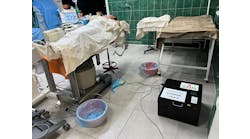New Ruling Allowing Microgrids for Health Care Facilities is “Seismic Shift”
Ten years ago, when surgeon David Bliss first started talking about using renewable energy, batteries and microgrids for health care facilities, people laughed at him.
“I was told, ‘This will never happen. You’re wasting your time. This will not get regulatory approval,’” said Bliss, who, in addition to being a practicing surgeon, is CEO of Faraday Microgrids, a developer of renewable energy microgrids. He was told that no hospitals would entertain the idea.
Now, nearly a decade later, he’s happy that his ideas have indeed come to fruition. That’s because of a recent decision by the Centers for Medicare and Medicaid Services (CMS) – an influential federal agency that reimburses the cost of a large percentage of health care services. In the past, the agency wouldn’t reimburse health care facilities for their costs unless they used fossil fuel as a backup option. The idea was to ensure the most reliable backup power for the facilities.
But resilient power has come a long way, and, with help from the California Energy Commission (CEC), the microgrid industry has demonstrated that microgrids can help provide lower cost, cleaner backup power. This helped convince the CMS to reach its decision about microgrids.
The CMS has issued a waiver that effectively allows microgrids to provide backup power to health care facilities, along with diesel generators, said Walt Vernon, CEO of Mazetti, a consulting firm that provides engineering and technology services. Long-term care facilities are excluded from the decision.
“This change is truly groundbreaking in the world of health facility design and is causing something of an uproar in the industry,” said Vernon.
Now health care facilities will be able to use solar, batteries, fuel cells, wind turbines and other renewable energy technologies. This opens the door for increased resilience, cost savings and carbon emission reductions, said Chris Evanich, program director of energy as a service for Schneider Electric.
“This is big news, it will allow health care facilities to use microgrids for resilience,” Evanich said.
Up until the CMS released its decision, the agency required health care organizations to follow specific guidelines to protect the quality of health care, Vernon explained.
The requirements, in general, called for the use of fossil-fired generators for backup power for most health facilities. These requirements are based on National Fire Protection Association codes.
“That’s been a very solid system but has had its weaknesses,” said Bliss.
For example, flooding during Hurricane Katrina swamped power systems on the East Coast and, in some cases, health care facilities running on diesel as backup ran out of diesel fuel, he said.
In addition, fires that led to outages and public safety power shutoffs have imperiled hospital power supplies, he added.
The move allowing microgrids and renewable energy to participate as backup resources evolved over a number of years, said Vernon, who has been lobbying for changes to the rules for many years.
A microgrid installed at a health care facility in Richmond, California, demonstrated the effectiveness of the technology. With a grant from the CEC, the microgrid, from Faraday Microgrids (formerly Charge Bliss), aimed to eliminate the use of diesel fuel backup. It was the first hospital capable of islanding without diesel.
Another Faraday Microgrids project in Ontario, California, is 10 times the capacity of the Richmond microgrid, can operate 10 hours or more in island mode and has a more diverse array of assets. It will support critical functions, including emergency room operations, ventilators, imaging and operating rooms.
This will be the largest capacity health care microgrid built to date in California, demonstrating just how much microgrids can benefit health care facilities.
Another factor encouraging the CMS code change is a move toward microgrids on the part of the National Electric Code. The 2023 edition now permits the use of microgrids in health care facilities.
The Inflation Reduction Act (IRA) will also help health care entities realize the benefits of the CMS decision. Under the IRA, nonprofits, including many hospitals, can get direct pay benefits for the federal Investment Tax Credit.
“Hospitals can take advantage of microgrids and get the direct pay option to cut net capital costs. Now that the technology is being shown as effective, it’s a wonderful perfect storm,” said Bliss.
Evanich added that the US Department of Health and Human Services has been pushing for health care facilities to lower their carbon emissions. Now, with the IRA benefits and the decision from the CMS, the health care industry can demonstrate some innovation and meet carbon reduction goals, he said. Health care facilities can also reduce their energy costs and emissions in their communities.
Most health care institutions don’t want to put up the capital for a microgrid, said Evanich. That’s especially true because they are cash-strapped coming out of the COVID-19 pandemic, he added.
Health care institutions would prefer to have someone else make the investment, monetize the tax credits available through the IRA and pass the savings onto the health care facilities. And health care facilities can do that by utilizing energy-as-a-service to finance their microgrids, said Evanich.
“Under energy-as-a-service, a third party monetizes the tax credits, pays less for the equipment and offers a lower cost of energy for the facility,” Evanich said.
Overall, the CMS decision is good for health care and good for the microgrid industry.
“This is a seismic shift for the health care industry,” said Bliss.
Track news about microgrid projects. Subscribe to the free Microgrid Knowledge Newsletter, which offers new content three times a week.








